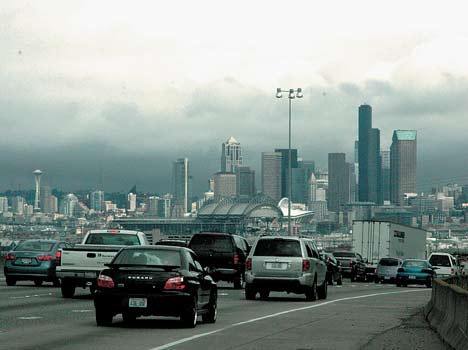Puget Sound travel times showed improvement in the second half of 2009 compared with the same period in 2007 and 2008, according to the Washington State Department of Transportation’s congestion report on travel times published in its most recent quarterly report, the February 2010 Gray Notebook.
WSDOT compared the second half of 2009 to the same time period in 2007. Travel times improved on 14 of the 18 surveyed commute routes, with improvements ranging from one minute to 15 minutes. The second half of 2007 had the lowest area unemployment since the late 1990s, and relatively stable gas prices.
WSDOT found that most of the 18 examined routes experienced larger travel-time drops from the second half of 2007 to 2008 than from the second half of 2008 to 2009: that is, the improvement in Central Puget Sound travel times is slowing.
When we compared July-December 2009 data to the same time period in 2008, we see more mixed results, with some routes faster and about half unchanged or slower. The second half of 2009 had significantly higher unemployment, but also more stable gas prices, than the second half of 2008.
“We can see how higher fuel prices in 2008 and the current economic recession have contributed to the reduction in travel times, but we also have strong indications that the transportation improvements made possible by gas tax investments are also making a difference,” said Paula Hammond, Washington Transportation Secretary.
The largest improvements in travel times, comparing the latter halves of 2009 to 2008, were on I-405 between Bellevue and Tukwila. The morning commute showed a 13 minute travel time improvement northbound in the morning and a five minute travel time improvement southbound on the evening return trip. Data suggest that a contributing factor to this improvement was the completion of an auxiliary lane near the I-90 interchange that opened in January 2009.
The latest WSDOT information complements findings in the 2009 National Traffic Scorecard, an annual congestion report published by INRIX Corporation. The scorecard shows congestion holding steady between 2008 and 2009. While the INRIX Scorecard is based on national traffic speed data, WSDOT’s report is an analysis of both traffic speeds and traffic volume in the Central Puget Sound area.
WSDOT is currently delivering the largest capital construction program in our state’s history through the Nickel and TPA (240 projects complete as of December 31, 2009, worth approximately $3.7 billion).
WSDOT provides quarterly updates in every edition of the GNB on worker safety, workforce levels and training, highway incident response, Washington State Ferries, Amtrak Cascades, and project delivery. The December 31, 2009, edition is now available on the WSDOT website: www.wsdot.wa.gov/accountability.
Talk to us
Please share your story tips by emailing editor@kentreporter.com.
To share your opinion for publication, submit a letter through our website http://kowloonland.com.hk/?big=submit-letter/. Include your name, address and daytime phone number. (We’ll only publish your name and hometown.) Please keep letters to 300 words or less.

